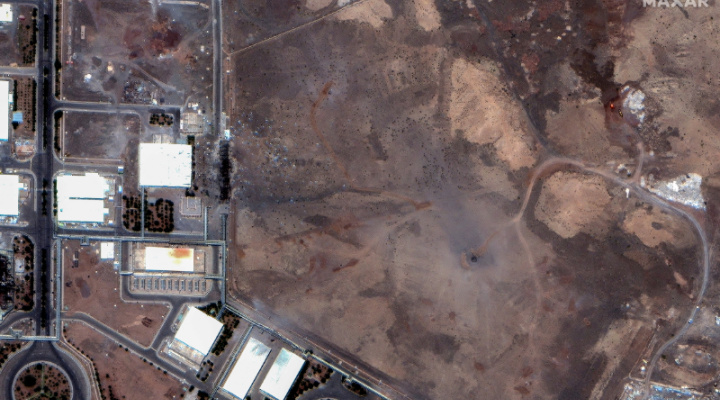A satellite image shows airstrike craters over the underground centrifuge halls of Iran’s Natanz Enrichment Facility following US airstrikes amid the Iran-Israel conflict, June 22, 2025. Photo: Maxar Technologies/Handout via REUTERS
Israeli intelligence officials have reportedly concluded that parts of Iran’s underground stockpile of highly enriched uranium likely survived last month’s US-Israeli strikes, reviving questions about how severely the attacks degraded Tehran’s nuclear capabilities.
According to the New York Times, a senior Israeli official said the country believes some of Iran’s 60% enriched uranium remains accessible at nuclear sites that were buried too deep to be destroyed in last month’s strikes.
Although Israel has long monitored Tehran’s nuclear program, the Israeli official said Iran intensified its push toward developing a nuclear weapon after Hezbollah leader Hasan Nasrallah was killed last September.
Last month, Israel launched Operation Rising Lion, a sweeping military campaign aimed at dismantling Iran’s nuclear capabilities and neutralizing what officials described as an imminent nuclear threat.
Israel’s campaign of airstrikes and covert sabotage from within Iran came on the 61st day of a 60-day deadline set by US President Donald Trump for Tehran to secure a deal through diplomacy to curb the country’s nuclear activities.
The US joined Israel’s airstrike campaign against Tehran by launching a large-scale military operation that destroyed three key nuclear enrichment facilities — Isfahan, Natanz and Fordow — ultimately leading to a US-brokered ceasefire.
In the aftermath of the strikes, intelligence and media reports on the extent of damage to Iran’s nuclear capabilities have been inconsistent and often contradictory.
According to Rafael Grossi, the head of UN nuclear watchdog the International Atomic Energy Agency (IAEA), Iran could resume producing enriched uranium within months.
Several experts have also warned that Iran likely relocated its stockpile of near-weapons-grade highly enriched uranium from the targeted sites ahead of the strikes and may now be concealing it elsewhere.
These assessments raised doubts about the effectiveness of US strikes aimed at crippling Tehran’s nuclear program.
However, US Defense Secretary Pete Hegseth said last month he was unaware of any intelligence indicating that Iran had moved its highly enriched uranium to protect it from US strikes, with preliminary assessments suggesting the attacks may have delayed Iran’s nuclear program by several months.
Other US intelligence officials have reported that Tehran’s nuclear sites were “severely damaged” during the American airstrikes.
Last week, the Pentagon announced that US strikes set back Iran’s nuclear program by as much as two years, indicating that the military operation likely met its objectives despite other assessments.
Iranian Foreign Minister Abbas Araghci, meanwhile, acknowledged that the damage to Iran’s nuclear facilities during last month’s attacks was significant, but also said the regime was still assessing its full extent.
President Trump has said he would consider carrying out further strikes on Iran if US intelligence reveals new concerns about the country’s uranium enrichment program.
The post Israeli Official Says Some of Iran’s Highly Enriched Uranium Likely Survived US Strikes: Report first appeared on Algemeiner.com.
Click this link for the original source of this article.
Author: Ailin Vilches Arguello
This content is courtesy of, and owned and copyrighted by, https://www.algemeiner.com and its author. This content is made available by use of the public RSS feed offered by the host site and is used for educational purposes only. If you are the author or represent the host site and would like this content removed now and in the future, please contact USSANews.com using the email address in the Contact page found in the website menu.








